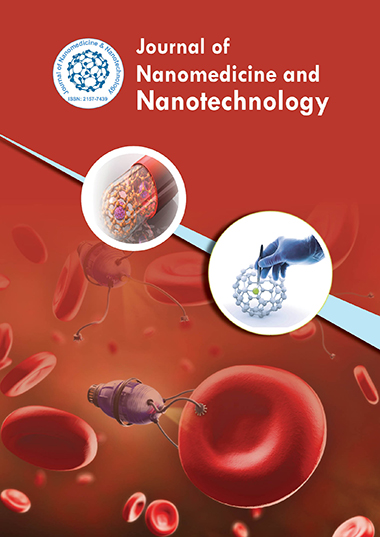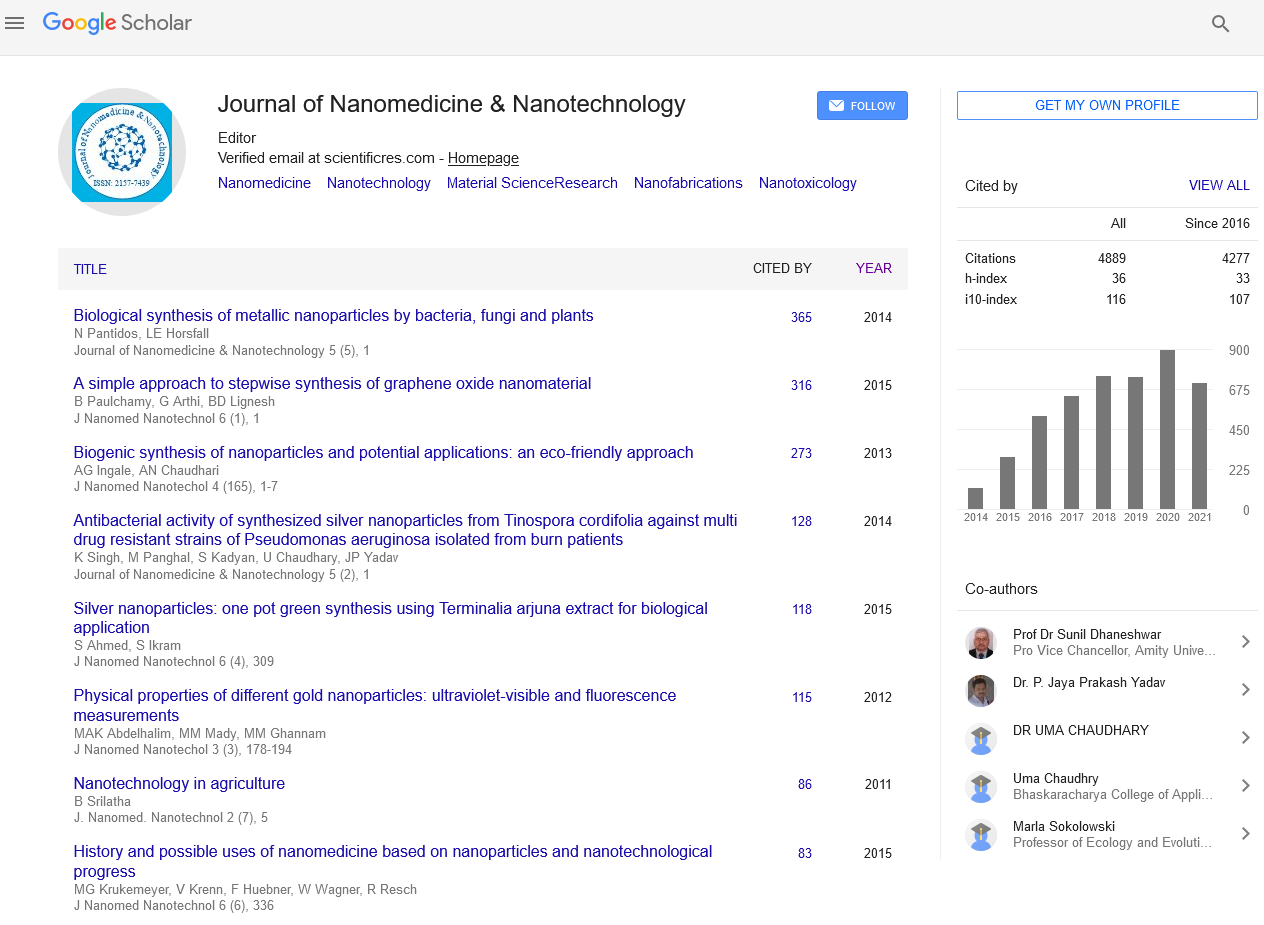Indexed In
- Open J Gate
- Genamics JournalSeek
- Academic Keys
- JournalTOCs
- ResearchBible
- China National Knowledge Infrastructure (CNKI)
- Scimago
- Ulrich's Periodicals Directory
- Electronic Journals Library
- RefSeek
- Hamdard University
- EBSCO A-Z
- OCLC- WorldCat
- SWB online catalog
- Virtual Library of Biology (vifabio)
- Publons
- MIAR
- Scientific Indexing Services (SIS)
- Euro Pub
- Google Scholar
Useful Links
Share This Page
Journal Flyer

Open Access Journals
- Agri and Aquaculture
- Biochemistry
- Bioinformatics & Systems Biology
- Business & Management
- Chemistry
- Clinical Sciences
- Engineering
- Food & Nutrition
- General Science
- Genetics & Molecular Biology
- Immunology & Microbiology
- Medical Sciences
- Neuroscience & Psychology
- Nursing & Health Care
- Pharmaceutical Sciences
Editorial - (2024) Volume 15, Issue 5
The Role of Nanotechnology in Combating Antibiotic Resistance
Wei Zhang*Received: 03-Sep-2024, Manuscript No. jnmnt-24-27138; Editor assigned: 05-Sep-2024, Pre QC No. jnmnt-24-27138 (PQ); Reviewed: 20-Sep-2024, QC No. jnmnt-24-27138; Revised: 24-Sep-2024, Manuscript No. jnmnt-24-27138 (R); Published: 30-Sep-2024, DOI: 10.35248/2157-7439.24.15.752
Abstract
Antibiotic resistance has emerged as one of the most critical global health challenges of the 21st century, leading to increased morbidity, mortality, and healthcare costs. Traditional strategies to combat this issue have proven inadequate, necessitating innovative solutions. Nanotechnology has shown significant promise in addressing antibiotic resistance through enhanced drug delivery systems, the development of novel antimicrobial agents, and innovative strategies for biofilm disruption. This article explores the multifaceted role of nanotechnology in combating antibiotic resistance, detailing various approaches, mechanisms, and future directions for research.
Keywords
Nanotechnology; Antibiotic Resistance; Drug Delivery; Antimicrobial Agents; Biofilms; Nanomaterials; Nanocarriers; Public Health
INTRODUCTION
Antibiotic resistance occurs when bacteria evolve mechanisms to resist the effects of drugs that once effectively treated infections. This phenomenon is exacerbated by over-prescription of antibiotics, poor infection control in healthcare settings, and the lack of new antibiotics entering the market. According to the World Health Organization (WHO), antibiotic-resistant infections are responsible for 700,000 deaths annually, and this figure could rise to 10 million by 2050 if current trends continue.
In this context, nanotechnology—defined as the manipulation of matter on a molecular scale—offers innovative strategies to tackle antibiotic resistance [1]. By leveraging the unique properties of nanomaterials, researchers can develop new approaches to enhance the efficacy of existing antibiotics, create novel antimicrobial agents, and overcome the barriers posed by biofilms. This article will review the various roles of nanotechnology in combating antibiotic resistance, focusing on the mechanisms of action, applications, and future perspectives.
THE MECHANISMS OF ANTIBIOTIC RESISTANCE
Genetic Mechanisms
Bacteria can acquire resistance genes through various means, including
Mutation: Spontaneous mutations can alter the target site of antibiotics.
Horizontal Gene Transfer: Bacteria can exchange genetic material through transformation, transduction, or conjugation, leading to the spread of resistance [2].
Physiological Mechanisms
Bacteria employ several physiological strategies to resist antibiotics, such as:
Efflux Pumps: These proteins actively expel antibiotics from the bacterial cell, reducing drug concentration.
Biofilm Formation: Biofilms provide a protective environment for bacteria, making them significantly less susceptible to antibiotics.
NANOTECHNOLOGY APPLICATIONS IN COMBATING ANTIBIOTIC RESISTANCE
Nanoparticles as Antimicrobial Agents
Types of Nanoparticles
Various types of nanoparticles have been studied for their antimicrobial properties, including
Metal Nanoparticles: Silver, gold, copper, and zinc oxide nanoparticles exhibit intrinsic antibacterial activity. Silver nanoparticles (AgNPs) are particularly noted for their effectiveness against a wide range of pathogens [3].
Polymeric Nanoparticles: Biodegradable polymers can be engineered to deliver antimicrobial agents in a controlled manner, enhancing their efficacy and reducing toxicity.
Carbon-Based Nanomaterials: Graphene and carbon nanotubes have shown promising antimicrobial properties, often attributed to their high surface area and ability to generate reactive oxygen species (ROS).
MECHANISMS OF ACTION
Nanoparticles exert their antimicrobial effects through several mechanisms
Disruption of Cell Membranes: Nanoparticles can penetrate and disrupt bacterial membranes, leading to cell death.
Generation of Reactive Oxygen Species (ROS): Certain nanoparticles generate ROS that can damage bacterial DNA, proteins, and lipids [4].
Release of Ions: Metal nanoparticles can release ions (e.g., Agâº) that possess antibacterial properties, further enhancing their efficacy.
Nanotechnology in Drug Delivery
Nanocarriers for Antibiotics
Nanocarriers, such as liposomes, micelles, and dendrimers, can improve the delivery of antibiotics, addressing issues related to solubility, stability, and bioavailability.
Liposomes: These lipid-based carriers can encapsulate hydrophilic and hydrophobic antibiotics, providing targeted delivery and controlled release.
Dendrimers: Dendrimers can be functionalized with targeting ligands to enhance the specificity of antibiotic delivery to infected tissues.
Enhancing Antibiotic Efficacy
Nanocarriers can enhance the efficacy of antibiotics by
Overcoming Resistance Mechanisms: By altering the pharmacokinetics of antibiotics, nanocarriers can help bypass efflux pumps and improve drug accumulation within bacterial cells [5].
Targeting Biofilms: Nanocarriers can be designed to penetrate biofilms and deliver antibiotics more effectively, increasing treatment success rates.
Nanotechnology for Biofilm Disruption
Biofilms are structured communities of bacteria that adhere to surfaces and are embedded in a self-produced extracellular matrix [6]. They are notoriously resistant to antibiotics and are responsible for a significant number of chronic infections.
Mechanisms of Biofilm Resistance
Reduced Penetration: The dense matrix limits the diffusion of antibiotics.
Altered Microenvironment: The microenvironment within biofilms can protect bacteria from immune responses and antibiotic action.
Nanoparticle-Based Approaches
Nanoparticles can disrupt biofilms through
Matrix Degradation: Enzyme-loaded nanoparticles can degrade the extracellular matrix, facilitating antibiotic penetration [7].
Physical Disruption: Certain nanoparticles can physically disrupt biofilm structures, enhancing the effectiveness of antibiotics.
Combination Therapies
Combining nanotechnology with traditional antibiotics can enhance therapeutic efficacy and combat resistance.
Synergistic Effects
Using nanoparticles in conjunction with antibiotics can lead to synergistic effects, allowing for lower doses of antibiotics and reducing the likelihood of resistance development.
Nanoparticle-Enhanced Antibiotic Activity
Research has shown that nanoparticles can enhance the activity of existing antibiotics against resistant strains. For instance, AgNPs have been shown to potentiate the activity of β-lactam antibiotics against methicillin-resistant Staphylococcus aureus (MRSA) [8].
CASE STUDIES
Silver Nanoparticles in Infection Control
Silver nanoparticles have been extensively studied for their broad-spectrum antimicrobial properties. They have shown effectiveness against various bacteria, including MRSA and Escherichia coli. Their use in wound dressings has been particularly promising, providing a sustained release of silver ions that can prevent infections and promote healing [9].
Liposomal Antibiotic Delivery
Liposomal formulations of antibiotics, such as amikacin and vancomycin, have demonstrated improved efficacy in treating systemic infections. Studies have shown that liposomal formulations can enhance tissue penetration and reduce nephrotoxicity, making them a safer alternative for patients requiring high-dose antibiotic therapy.
CHALLENGES AND LIMITATIONS
Despite the promising applications of nanotechnology in combating antibiotic resistance, several challenges remain:
Regulatory Hurdles
The development and approval of nanotechnology-based therapies face significant regulatory challenges. Regulatory agencies require extensive safety and efficacy data, which can be time-consuming and costly to obtain.
Stability and Toxicity
Nanoparticles may exhibit varying stability and potential toxicity, which can complicate their clinical use. Understanding the long-term effects of nanomaterials in biological systems is crucial for their safe application.
Development of Resistance
While nanotechnology may initially overcome antibiotic resistance, there is a risk that bacteria could eventually develop resistance to nanoparticle-based therapies as well. Continuous monitoring and adaptation of strategies will be essential.
FUTURE DIRECTIONS
Personalized Nanomedicine
Advancements in personalized medicine may allow for the tailoring of nanotechnology-based therapies to individual patient needs. Personalized approaches could enhance treatment efficacy and reduce the risk of resistance development.
Integration of Nanotechnology with Genomics
Combining nanotechnology with genomics could lead to the development of targeted therapies based on an individual’s specific resistance mechanisms, optimizing treatment regimens [10].
Public Health Initiatives
Efforts to educate healthcare professionals and the public about the appropriate use of antibiotics, alongside the integration of nanotechnology, will be essential in combating antibiotic resistance on a global scale.
CONCLUSION
Nanotechnology holds significant promise in the fight against antibiotic resistance. Through the development of novel nanocarriers, antimicrobial nanoparticles, and strategies for biofilm disruption, researchers are paving the way for more effective therapies. However, addressing the challenges associated with safety, regulatory approval, and potential resistance development will be critical for the successful translation of these technologies into clinical practice. Continued research and collaboration across disciplines will be essential to harness the full potential of nanotechnology in combating one of the most pressing public health challenges of our time.
REFERENCES
- Almomani F, Bhosale R, Khraisheh M, Almomani T. Heavy metal ions removal from industrial wastewater using magnetic nanoparticles (MNP). Appl Surf Sci.2020; 506: 144924.
- Zulfiqar N. Effect of adding surfactant additives (sodium lauryl sulphate) in water on the performance of flat plate solar distillation system for the purification of water. 2023.
- Poole C P, Owens F J. Introduction to nanotechnology. 2003.
- Fulekar M. Nanotechnology: importance and applications. IK International Pvt Ltd. 2010.
- KaradeV, Waifalkar P, Dongle T, Sahoo S C, Kollu P, Patil P et al. Greener synthesis of magnetite nanoparticles using green tea extract and their magnetic properties. Mater Res Express.2017; 4(9): 096102.
- Alfredo V, Isaías J, Hernandez E, Perez S, Angelica L, Landeros Sanchez B. Synthesis and characterization of magnetite nanoparticles for photocatalysis of nitrobenzene. J Saudi Chem Soc.2020; 24(2): 223-235.
- Avasthi A, Caro C, Pozo-Torres E, Leal M P, García‑Martín M L. Magnetic Nanoparticles as MRI Contrast Agents. Topics in current chemistry.2020; 378(3): 40.
- Liu S, Yu B, Wang S, Shen Y, Cong H. Preparation, surface functionalization and application of Fe3O4 magnetic nanoparticles. Adv. Colloid Interface Sci.2020; 102165.
- Mirza S, Ahmad M S, Shah A, Ateeq M. Magnetic nanoparticles: drug delivery and bioimaging applications. 2020; 189-213.
- Iravani S, Korbekandi H, Mirmohammadi S V, Zolfaghari B. Synthesis of silver nanoparticles: chemical, physical and biological methods. Int J Pharm Sci.2014; 9(6): 385.
Indexed at, Google Scholar, Crossref
Indexed at, Google Scholar, Crossref
Indexed at, Google Scholar, Crossref
Indexed at, Google Scholar, Crossref
Indexed at, Google Scholar, Crossref
Indexed at, Google Scholar, Crossref
Indexed at, Google Scholar, Crossref
Citation: Wei Z (2024) The Role of Nanotechnology in Combating Antibiotic Resistance. J Nanomed Nanotech. 15: 752.
Copyright: ©2024 Wei Z. This is an open-access article distributed under the terms of the Creative Commons Attribution License, which permits unrestricted use, distribution, and reproduction in any medium, provided the original author and source are credited.
Competing interests: The authors have declared that no competing interests exist.


